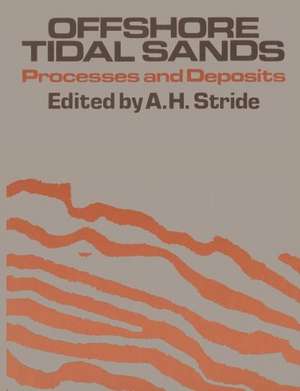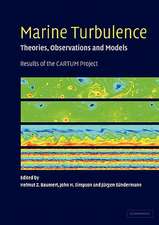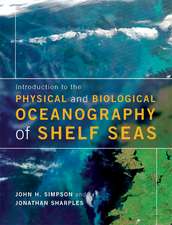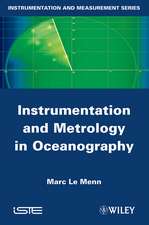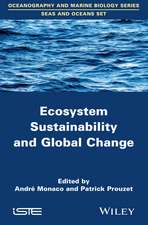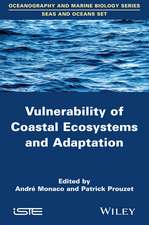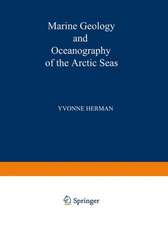Offshore Tidal Sands: Processes and deposits
Autor A. H. Stideen Limba Engleză Paperback – 15 oct 2011
Preț: 390.63 lei
Nou
Puncte Express: 586
Preț estimativ în valută:
74.75€ • 78.24$ • 62.21£
74.75€ • 78.24$ • 62.21£
Carte tipărită la comandă
Livrare economică 31 martie-14 aprilie
Preluare comenzi: 021 569.72.76
Specificații
ISBN-13: 9789400957282
ISBN-10: 9400957289
Pagini: 264
Ilustrații: XVI, 222 p.
Dimensiuni: 189 x 246 x 14 mm
Greutate: 0.48 kg
Ediția:Softcover reprint of the original 1st ed. 1982
Editura: SPRINGER NETHERLANDS
Colecția Springer
Locul publicării:Dordrecht, Netherlands
ISBN-10: 9400957289
Pagini: 264
Ilustrații: XVI, 222 p.
Dimensiuni: 189 x 246 x 14 mm
Greutate: 0.48 kg
Ediția:Softcover reprint of the original 1st ed. 1982
Editura: SPRINGER NETHERLANDS
Colecția Springer
Locul publicării:Dordrecht, Netherlands
Public țintă
ResearchCuprins
1. Background and outline.- 1.1 Introduction.- 1.2 History of research on modern offshore tidal current sedimentation.- 1.3 A depositional surface for late Holocene deposits.- 1.4 Limits and outline of the book.- 2. Tidal currents of the continental shelf.- 2.1 Introduction.- 2.2 Tide generating forces and the ocean’s response.- 2.3 Tidal currents in shelf seas.- 2.4 Net sand transport caused by tidal current asymmetries.- 2.5 Flow near the sea floor.- 2.6 Internal tides.- 2.7 Tides past.- 2.8 Main conclusions.- 3. Bedforms.- 3.1 Introduction.- 3.2 Relevant flume bedforms.- 3.3 Transverse bedforms of the continental shelf 34.- 3.4 Longitudinal bedforms of the continental shelf.- 3.5 Relationship between bedforms.- 3.6 Aeolian equivalents.- 3.7 Main conclusions.- 4. Sand transport.- 4.1 Introduction.- 4.2 Relation of sand transport rate to tidal current speed.- 4.3 Geographical variation in sand transport rate.- 4.4 Net sand transport by tidal currents.- 4.5 Temporal variations of sand transport rate and direction in a tidal sea.- 4.6 Growth, migration and decay of sand waves in the Southern Bight of the North Sea by total water movements.- 4.7 Local sand transport on modern sand banks.- 4.8 Main conclusions.- 5. Offshore tidal deposits: sand sheet and sand bank facies.- 5.1 Introduction.- 5.2 Late Holocene sand and gravel sheet facies.- 5.3 Sand bank facies.- 5.4 Sediment and faunal indicators of shape, depth and exposure of continental shelves.- 5.5 Longer term evolution of the deposits.- 5.6 Sand and gravel deposits of non-tidal marine currents.- 5.7 Main conclusions.- 6. Shelly faunas associated with temperate offshore tidal deposits.- 6.1 Introduction.- 6.2 Faunal associations.- 6.3 Bioturbation.- 6.4 Topics and areas excluded.- 6.5 Temperate water regions studiedand their geological importance.- 6.6 Faunas in shallow nearshore waters.- 6.7 Faunas of the middle and outer continental shelf.- 6.8 Faunas of a bed-load parting.- 6.9 Faunas associated with bedform zones in the Western English Channel.- 6.10 Faunas associated with bedform zones in the Bristol Channel.- 6.11 Faunas associated with bedform zones in the Southern North Sea.- 6.12 Faunas associated with bedform zones on the Atlantic continental shelf between Brittany and Scotland.- 6.13 Faunas of active sand banks.- 6.14 Faunal evidence for stability of sand waves.- 6.15 Faunas as environmental indicators.- 6.16 Factors determining the faunal composition of death assemblages in shell gravels.- 6.17 Age of temperate water carbonates.- 6.18 Relative proportions of the major carbonate producers in death assemblages of continental shelf carbonates.- 6.18.1 Faunal composition of death assemblages in shell gravels in the strong current areas, Western English Channel and Celtic Sea.- 6.18.2 Faunal composition of death assemblages in shell gravels on the continental shelf west of Scotland.- 6.19 Temporal changes in the faunal composition of shell gravels.- 6.20 Long term evolution of temperate shelf carbonates.- 6.21 Applications to the fossil record.- 6.22 Main conclusions.- 7. Ancient offshore tidal deposits.- 7.1 Introduction.- 7.2 Recognition of ancient offshore tidal current activity.- 7.3 Structures preserved in ancient offshore tidal current deposits.- 7.4 Tidal currents aided by storm processes.- 7.5 Factors controlling the structure and composition of offshore tidal sediments through geological time.- 7.6 Some possible palaeotidal regimes.- 7.7 Sedimentology of a tidal sea: the Lower Greensand of southern England.- 7.8 Tidal currents through geological time: implicationsfor future studies.- 7.9 Main conclusions.- REFERENCES.
